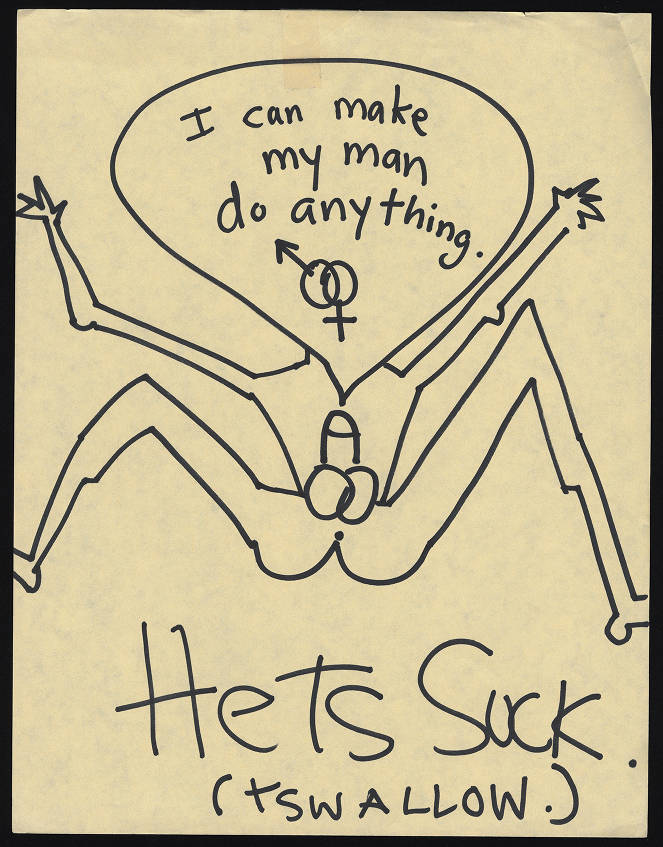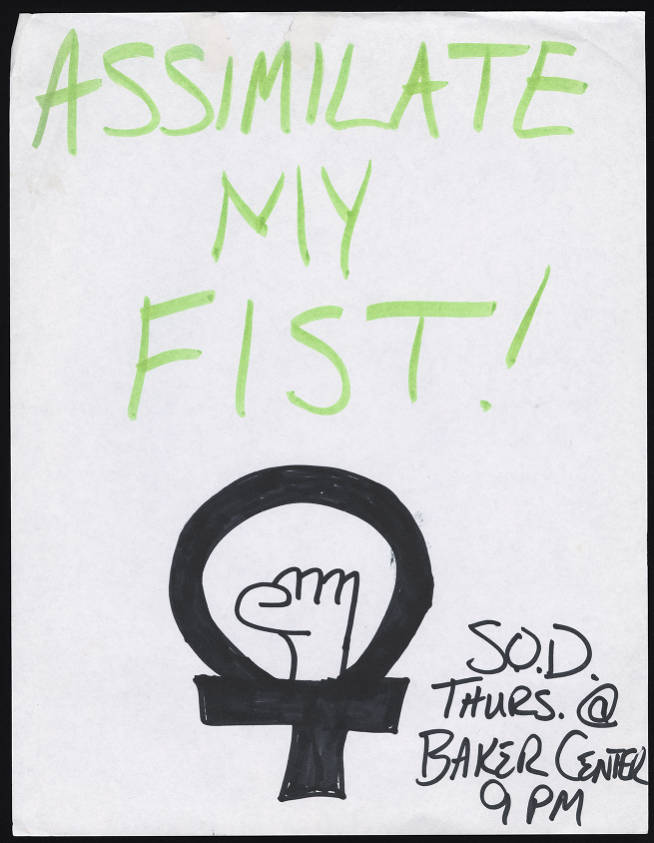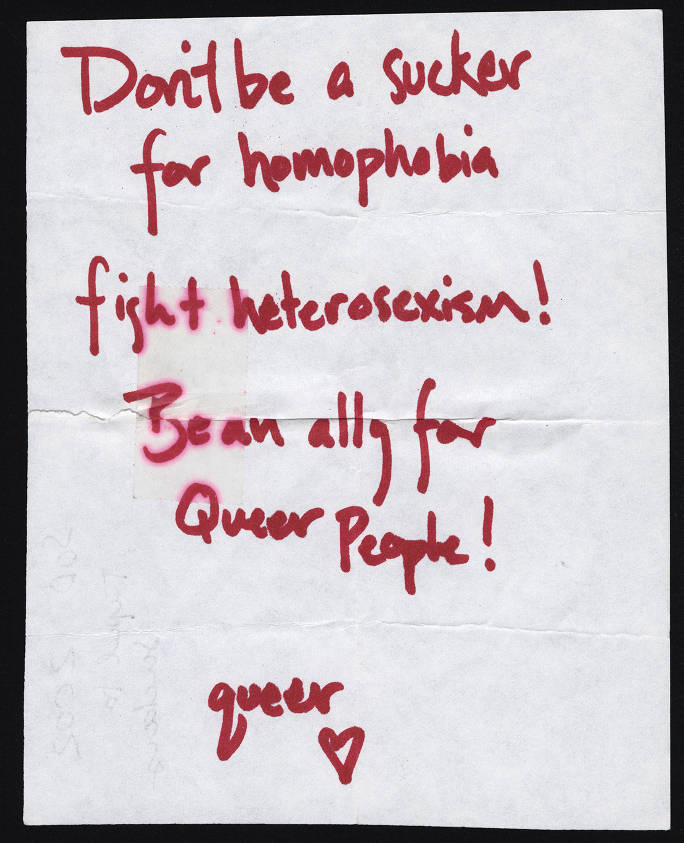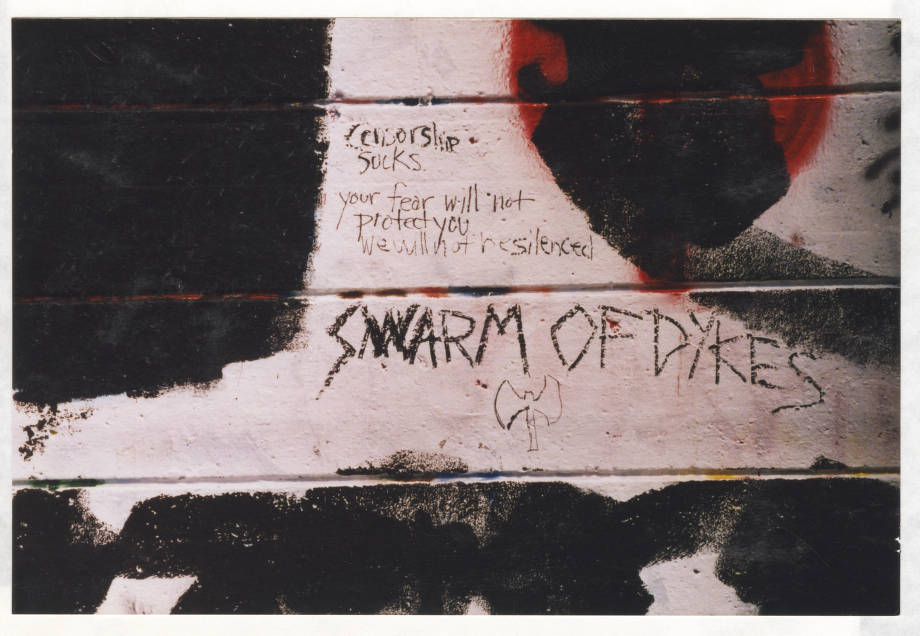By Julia Weber, Journalism ‘25, Maddie Kiefer, Journalism ‘25 and Katrina Carlson, Journalism ‘26, for JOUR 4130 Gender, Race, and Class in Journalism and Mass Media with Victoria LaPoe, Fall 2024.
During the fall 2024 semester, the staff of the Mahn Center for Archives and Special Collections worked intensively with Victoria La Poe’s JOUR 4130 class, Gender, Race, and Class in Journalism and Mass Media. The students explored, selected, and researched materials from the collections, then worked in small groups to prepare presentations. The students had the option to then expand their research into a blog post like this one for their final project.
The vanguard student advocacy group Swarm of Dykes changed narratives and fostered belonging for OHIO LGBT students in the early 2000s.
Ohio University has a long legacy of student protest movements and one of the leading organizations was the student organization Swarm of Dykes, which advocated for LGBTQ+ liberation in the early 2000s.
The collection of posters made by Swarm of Dykes are housed in the Ohio University digital archives and highlight an important glimpse into a cultural conversation which took place in the early 2000s and, in many aspects, is still happening today. For JOUR 4130: Gender, Race, and Class in Journalism and Mass Media, we studied the Swarm of Dykes collection of ephemera to better understand how advocacy groups and marginalized communities can use effective communication skills to steer conversations and shape narratives.
The effectiveness of these posters lies in their portrayal of belonging to the LGBTQ+ community as a joyful, prideful thing. Amid so much negative stereotyping, Swarm of Dykes’ positive messaging encouraged LGBTQ+ individuals to take pride in their identity and celebrate it rather than feeling ashamed of a core part of who they are.
In the do-it-yourself (DIY) posters made by groups like Swarm of Dykes, the target audience is queer people, sometimes even going as far as including messaging that is ostracizing heterosexual audiences. The point of the advertisements or messaging is to incite shock value from traditional audiences, while signaling for acceptance from other (queer) audiences. This is a radical approach, one that exceeds the typical acceptance through assimilation.
Swarm of Dykes used a number of different media and communication theories to disseminate their message to the general public. Among these, the most dominant media theories were gatekeeping theory, framing theory, agenda-setting theory and spiral of silence theory. By turning the more dominant narrative on its head, Swarm of Dykes were able to upset the narrative and bypass gatekeepers to spread awareness and advocacy for queer liberation.
By cultivating an ironic, tongue-in-cheek tone and bright, bold colors to create shock value, Swarm of Dykes employed framing theory, a media theory focused on the way information is presented to audiences, to disrupt the narrative and foster a more positive one by showing the absurdity of heteronormative messaging in media.
Despite mass media’s complacency in the spiral of silence through its hesitancy to change the narrative, direct action advocacy groups like Swarm of Dykes were able to bypass news coverage and spread their message of their own accord through the DIY messaging which we see in this archival collection. The tone and visual appeal of the posters help to flip the narrative through humor, irony and other persuasive tactics.
Within the media, gatekeeping is a way privileged communities control the information that gets out to the public. The LGBTQ+ community is regularly a victim of this, especially in conservative areas or cultures, as they tend to not want the expression or information regarding it. That harms the community, especially one like the LGBTQ+, where many people are trying to figure themselves out, and if they fall into one of the areas where gatekeeping is prominent, they might feel alone or like they are the only ones. All of that ties into how DIY communities, such as the Swarm of Dykes, bypass traditional gatekeeping and uplifts underserved communities.
In the period in which these posters were produced, mainstream media was hesitant to cover the LGBTQ+ community in a positive light, due to the agenda setting that goes into selecting national news content. Agenda setting refers to the content and media that news broadcasts choose to report on, often setting up what people should think about. Often wishing to avoid controversy or bad ratings, news media shied away from covering controversial LGBTQ+ advocacy stories.

This fostered a spiral of silence, an effect in media theory in which lack of visible coverage of a given topic makes individuals less likely to voice their opinions on it. Because mass media was hesitant to cover the LGBTQ+ community, LGBTQ+ individuals had to overcome this spiral of silence to engage in self-advocacy through initiatives like Swarm of Dykes.
Organizations such as Swarm of Dykes paint, draw, and create their own posters and other media to recruit members and raise awareness of their club. The media they produced such as the “hets suck” poster that shows nudity and has controversial language associated with it, would never be accepted by a traditional printing press or news station because of the opposition to the LGBT community and fear of picking a political side at the time in which it was created. By creating their own work, they can be as vulgar and political as they please because it is not associated with any major news outlet. Through that, the gatekeeping theory does not affect them, and they use their media to uplift an underprivileged community, the LGBTQ+.
The target audience of the radical messaging was not only the dominant heteronormative culture, but the much smaller queer community that lived, out or closeted, in Athens. The content was made so that others could gain confidence in their identities and showcase an example of discriminated people living a full truth despite hardships. It also confronts the conformist beliefs of heteronormative society, which may have outraged or confused many others.
Radical content is made with the intention of upsetting the norm beliefs. This content primes the audience to believe that LGBTQ+ people are radically themselves and showcase that they are present instead of being a silenced minority. It excludes heterosexual cisgender people to set the expectation that assimilation to heteronormative culture is not the goal, but rather an acceptance of queer culture.


Censorship can also be found within DIY messaging, especially messages as radical as the Swarm of Dykes’ proposed. The content was always meant to make an impact, but some individuals on campus vehemently disagreed with their message. In the Pride Center Collection, there is a folder of images showing when the SOD painted on the graffiti wall. Their messages and art was later covered by black paint, which then members of SOD returned with sharpie messages like, “censorship sucks” and “we will not be silenced.”

Sources:
“About Us.” Ohio University. https://www.ohio.edu/diversity/pride-center/about.
LaPoe, Victoria. “theoryspreadsheetupdate.” https://catmailohio-my.sharepoint.com/:x:/g/personal/lapoe_ohio_edu/EXrMKe-DFURLsu3RU8HVCHEBwcJGg02Ut3RDms3Jac7OEw?e=XKKw2U&CID=6c40ed36-30b9-ba06-0917-1eabfe7ae2e6&clickParams=eyJYLUFwcE5hbWUiOiJNaWNyb3NvZnQgT3V0bG9vayBXZWIgQXBwIiwiWC1BcHBWZXJzaW9uIjoiMjAyNDA5MjAwMDQuMTIiLCJPUyI6Ik1hYyBPUyBYIHVuZGVmaW5lZCJ9. [Class access only.]
Sloop, John. “Queer Approaches to Communication.” Vanderbilt University, 2009.
Serge, Lauren. “Swarm of Dykes: Swarm of Dykes’ activism influenced LGBTQ+ resources today.” The Post, September 13, 2021. https://projects.thepostathens.com/SpecialProjects/swarm-of-dykes-lgbtq-queer-ohio-university-activism-lgbt-center/#google_vignette.
Yep, G. et. all. “Queer Theory and Communication: From Disciplining Queers to Queering the Discipline(s).” Routledge, 2014.
Yount, Rachel. “Making Respect Visible: LGBTQ resources, history and culture at Ohio U.” The New Political, April 11, 2023. https://www.thenewpolitical.com/news/gi330iuz685pt2si8d3o4sc15o540w.